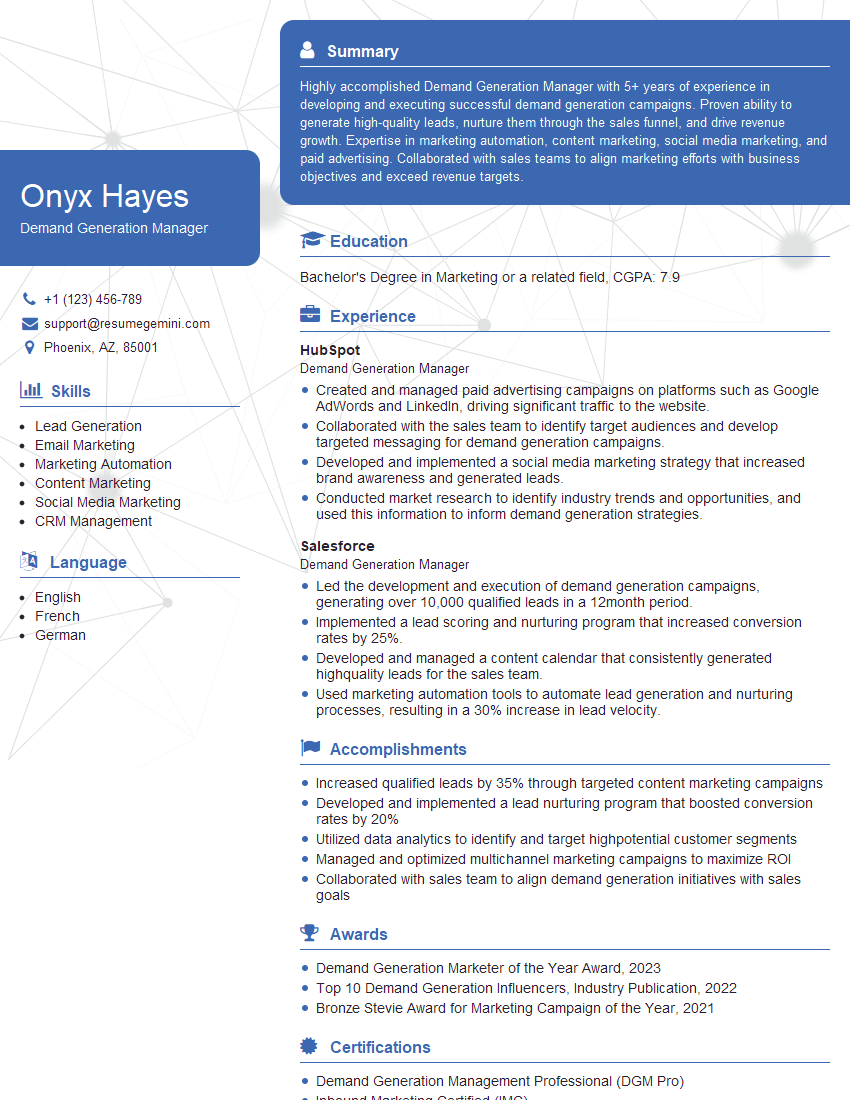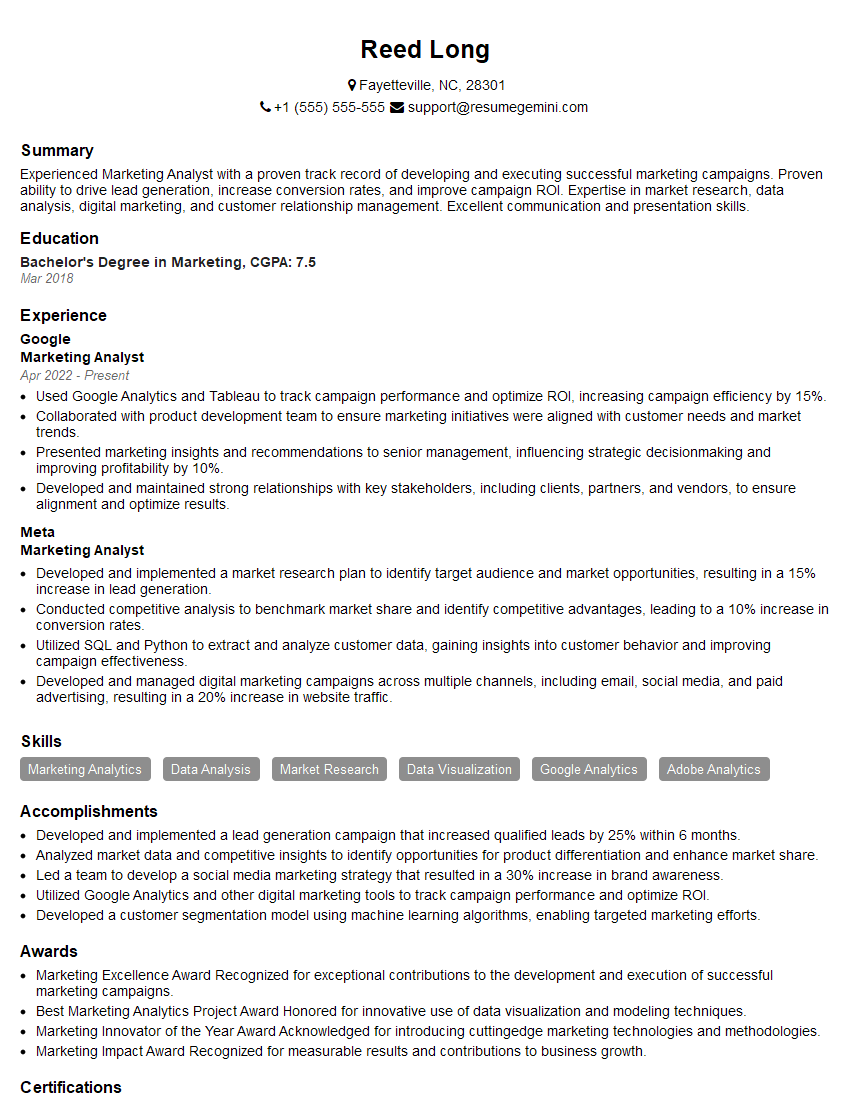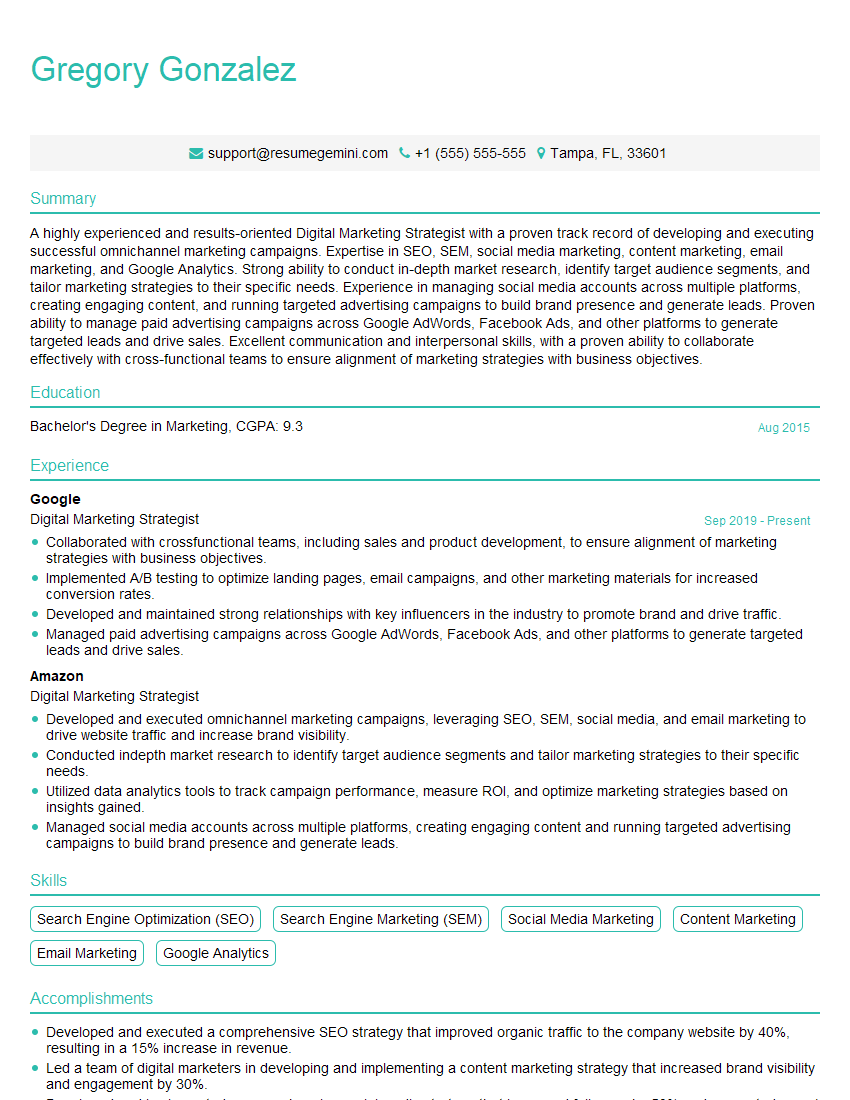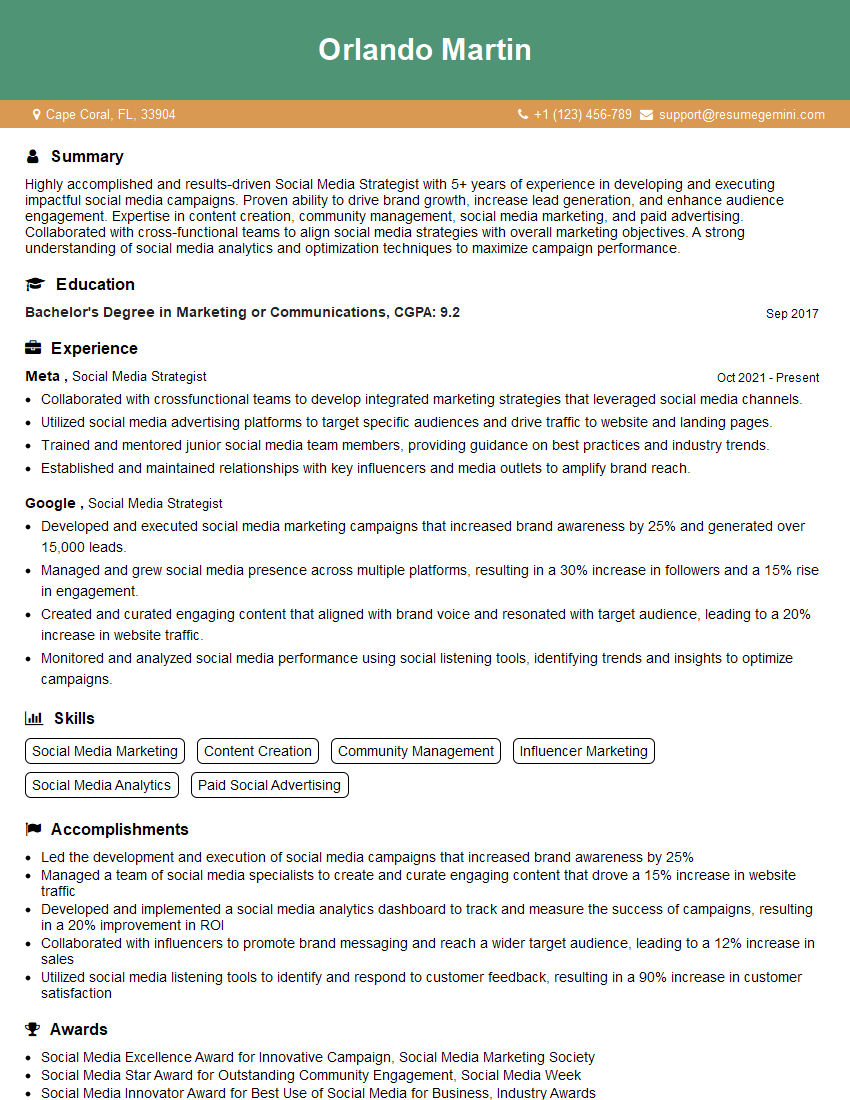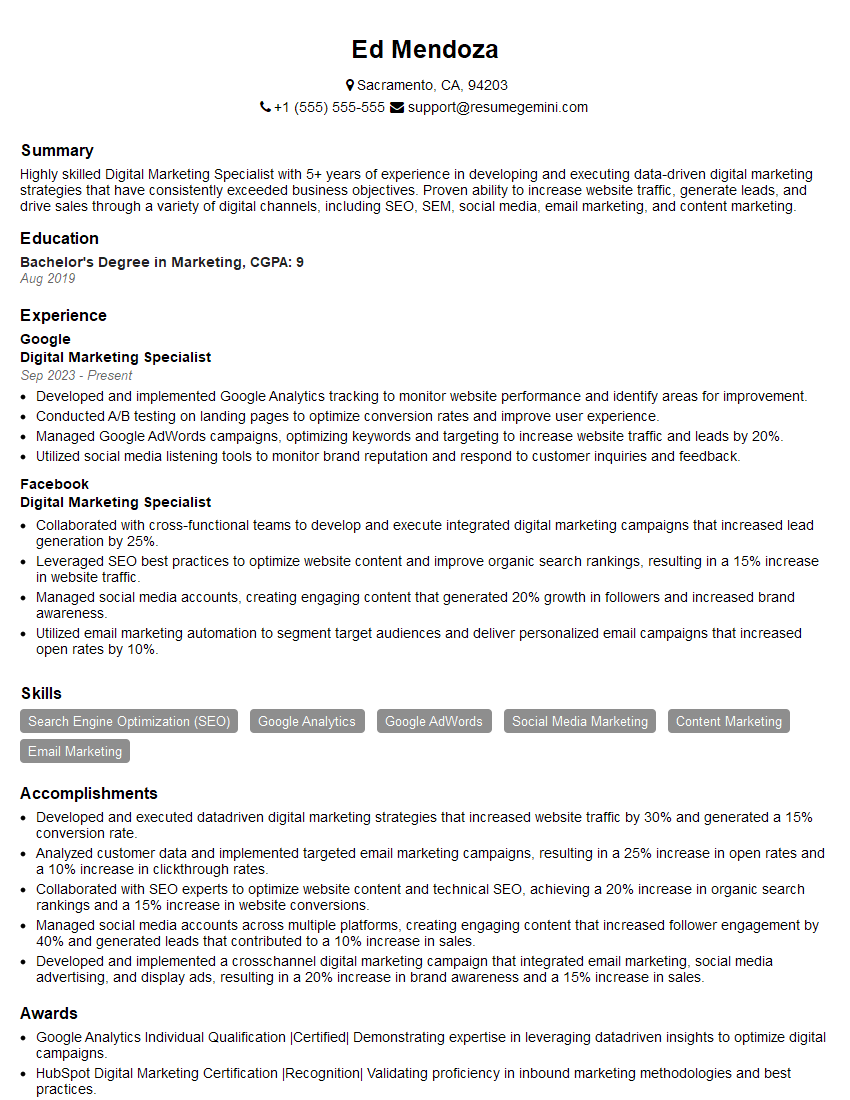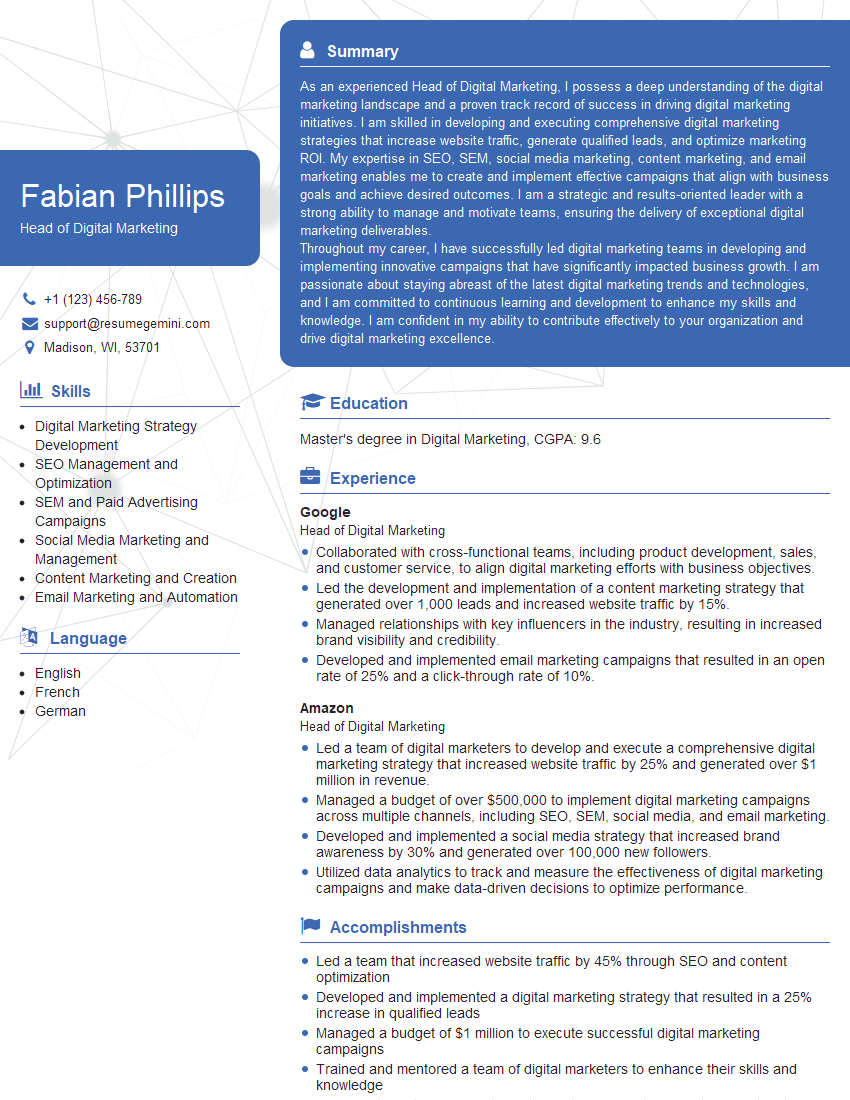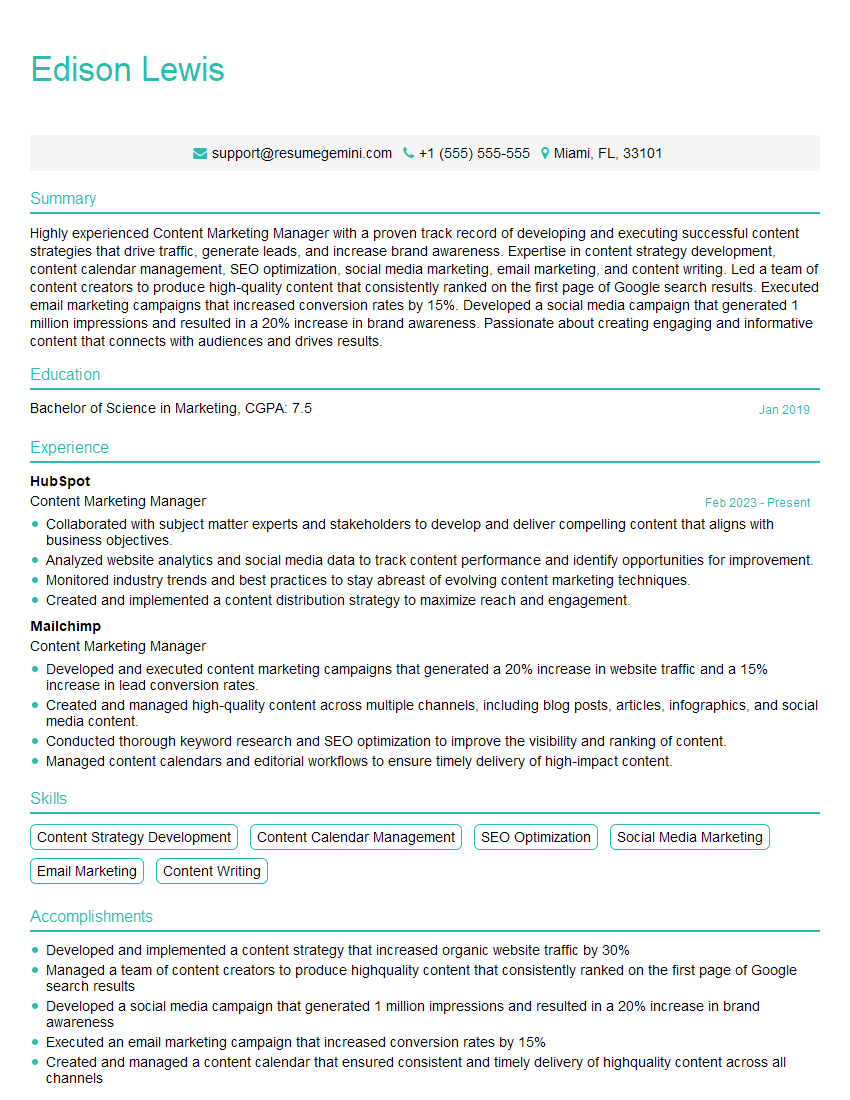Interviews are opportunities to demonstrate your expertise, and this guide is here to help you shine. Explore the essential Digital Marketing Strategy Development interview questions that employers frequently ask, paired with strategies for crafting responses that set you apart from the competition.
Questions Asked in Digital Marketing Strategy Development Interview
Q 1. Explain your understanding of the digital marketing funnel.
The digital marketing funnel is a visual representation of the customer journey, outlining the stages a potential customer goes through from initial awareness to becoming a loyal advocate. Think of it like a pipeline; you’re guiding potential customers through various stages until they convert into paying customers.
- Awareness: The customer becomes aware of your brand or product through various channels like social media ads, organic search, or content marketing.
- Interest: The customer shows interest by engaging with your content, exploring your website, or following your social media pages.
- Decision: The customer evaluates your product or service against competitors, considering its features, benefits, and price.
- Action: The customer takes the desired action, such as making a purchase, signing up for a trial, or downloading a resource.
- Retention/Advocacy: The customer becomes a loyal customer and potentially advocates for your brand through referrals or positive reviews.
For example, a customer might see a Facebook ad for a new fitness app (Awareness), then visit the app’s website to learn more (Interest), compare it to other fitness apps (Decision), download the app and start a free trial (Action), and ultimately become a paying subscriber who recommends it to friends (Retention/Advocacy).
Q 2. Describe your experience with SEO keyword research and implementation.
My SEO keyword research process starts with understanding the client’s business goals and target audience. I utilize tools like SEMrush, Ahrefs, and Google Keyword Planner to identify relevant keywords with high search volume and low competition. I analyze search intent – understanding what users are looking for when they search a specific keyword. This helps me prioritize keywords based on their relevance and potential to drive organic traffic.
Implementation involves optimizing website content, including title tags, meta descriptions, header tags (H1-H6), and image alt text with the chosen keywords. I also focus on building high-quality backlinks from reputable websites to improve domain authority. I monitor keyword rankings regularly using Google Search Console and other analytics platforms, making adjustments to our strategy as needed. For example, if we’re targeting ‘best running shoes for women’, I’d ensure this phrase appears naturally in our website copy, meta descriptions, and image alt text, alongside related long-tail keywords such as ‘best running shoes for women with flat feet’ or ‘best cushioned running shoes for women’.
Q 3. How do you measure the ROI of a digital marketing campaign?
Measuring the ROI of a digital marketing campaign requires a clear understanding of the campaign’s objectives and a structured approach to data collection and analysis. It’s not just about clicks and impressions; we need to connect digital marketing activities to concrete business outcomes.
I typically use a formula that focuses on the return on investment: (Revenue Generated - Marketing Spend) / Marketing Spend. To calculate ‘Revenue Generated’, I analyze changes in sales, leads, or other key metrics directly attributable to the campaign. I use tools like Google Analytics to track website traffic, conversions, and customer behavior. Attribution modeling plays a crucial role, helping us understand which marketing channels contributed most to the final conversion. For example, if a campaign cost $5000 and generated $25000 in revenue, the ROI is 400%. It’s crucial, however, to also consider the cost of customer acquisition (CAC) and customer lifetime value (CLTV) for a holistic view of campaign success.
Q 4. What are the key performance indicators (KPIs) you track for social media marketing?
The KPIs I track for social media marketing depend heavily on the campaign goals, but generally include:
- Reach and Impressions: How many unique users saw your content?
- Engagement: Likes, comments, shares, and saves – showing how users interacted with your posts.
- Website Clicks/Traffic: How many users clicked through from your social media posts to your website?
- Leads Generated: Number of qualified leads generated through social media campaigns (e.g., form submissions, email sign-ups).
- Conversions: Number of sales or other desired actions completed via social media.
- Brand Mentions: Tracking brand mentions helps understand brand awareness and sentiment.
- Follower Growth: Increase in followers over time – an indicator of audience growth.
I also pay attention to the social media platform-specific metrics, such as video views on YouTube or story interactions on Instagram. By analyzing these KPIs, I can identify what type of content resonates best with the audience, optimize our strategy, and ultimately improve the return on our social media investment.
Q 5. Explain your approach to A/B testing.
My approach to A/B testing is systematic and data-driven. It involves testing different versions of marketing assets to determine which performs best. This could be anything from subject lines in email marketing to website button colors or ad copy variations.
I follow a structured process:
- Define Hypothesis: Clearly state what you expect to improve and by how much (e.g., ‘Changing the button color from blue to green will increase click-through rate by 15%’).
- Create Variations: Develop variations of the asset, ensuring only one element is changed at a time to isolate the impact of each change.
- Choose Metrics: Identify the key metric(s) you will use to measure performance (e.g., click-through rate, conversion rate, time on page).
- Run the Test: Ensure sufficient traffic is directed to each variation to generate statistically significant results.
- Analyze Results: Use statistical analysis to determine which variation performed significantly better. Don’t just rely on small differences; confirm statistical significance to avoid drawing false conclusions.
- Implement the Winner: Once a winner is identified, implement the winning variation across all platforms.
For example, I might A/B test two different email subject lines to see which one generates a higher open rate. It’s important to use tools that support proper A/B testing and provide insights into statistical significance.
Q 6. How do you stay updated on the latest digital marketing trends?
Staying updated on digital marketing trends is crucial for success. I employ a multi-faceted approach:
- Industry Publications and Blogs: I regularly read publications like Search Engine Journal, Marketing Land, and Neil Patel’s blog to stay informed about the latest news, strategies, and best practices.
- Industry Events and Webinars: Attending conferences and webinars provides valuable insights and networking opportunities.
- Social Media: Following influencers, thought leaders, and marketing agencies on social media helps me discover emerging trends.
- Google Alerts: I set up Google Alerts for specific keywords to receive notifications about relevant news and articles.
- Competitor Analysis: Continuously monitoring competitors’ strategies allows me to identify new opportunities and adapt my own approach.
- Professional Development Courses: Taking online courses and workshops helps me enhance my skills and stay abreast of the latest technologies and tools.
This combined approach allows me to stay ahead of the curve and leverage the latest innovations to optimize our digital marketing strategies.
Q 7. Describe your experience with content marketing strategy development.
Developing a content marketing strategy begins with a thorough understanding of the target audience and their needs. I define clear objectives, whether it’s lead generation, brand awareness, or driving website traffic. I then conduct keyword research to identify relevant topics that align with the audience’s search intent and business goals.
I create a content calendar outlining the type of content (blog posts, infographics, videos, ebooks, etc.), publishing schedule, and distribution channels (social media, email marketing, website). I prioritize creating high-quality, engaging content that offers value to the audience. This process involves collaboration with writers, designers, and other stakeholders to ensure consistent brand messaging and visual appeal. Finally, I track and analyze content performance using analytics tools, making adjustments to the strategy based on data-driven insights. For example, if a certain type of blog post consistently receives high engagement, I will create more content of that nature. Conversely, if a certain content type underperforms, we will analyze why and make necessary changes to improve its effectiveness.
Q 8. What are your preferred tools for social media management?
My preferred tools for social media management are chosen based on the specific needs of each client and campaign. However, some of my favorites include Hootsuite and Buffer for scheduling and managing posts across multiple platforms. These tools offer excellent features for content calendar planning, performance tracking, and team collaboration. For more in-depth analytics and competitor analysis, I often leverage tools like Sprout Social and Brand24. Sprout Social provides insightful data on audience engagement and sentiment, while Brand24 helps monitor brand mentions and social listening. The selection process always involves considering factors like budget, the number of platforms being managed, and the desired level of analytics.
- Hootsuite: Excellent for scheduling and managing posts across multiple platforms. It’s particularly user-friendly for teams.
- Buffer: Similar to Hootsuite but with a slightly different interface and feature set; often preferred for its intuitive design.
- Sprout Social: Provides more in-depth analytics and reporting capabilities, ideal for demonstrating ROI.
- Brand24: Crucial for social listening, allowing proactive identification and response to brand mentions and crises.
Q 9. Explain your experience with email marketing automation.
Email marketing automation is central to my strategy for nurturing leads and driving conversions. My experience spans several platforms, including Mailchimp, Constant Contact, and ActiveCampaign. I’ve successfully implemented automated workflows for tasks like onboarding new subscribers, sending targeted email sequences based on user behavior (e.g., abandoned cart emails, welcome series), and segmenting audiences based on demographics and engagement. For example, for a client selling skincare products, I designed a personalized email series triggered by purchase history. Customers who bought a cleanser received follow-up emails suggesting compatible toners and moisturizers. This approach increased average order value and customer lifetime value significantly. Beyond pre-built workflows, I am proficient in using dynamic content to personalize email messages, which significantly improves open and click-through rates.
My approach emphasizes data-driven decision-making. I continuously monitor key metrics like open rates, click-through rates, conversion rates, and unsubscribes to optimize email campaigns and ensure they remain compliant with best practices and regulations like CAN-SPAM.
Q 10. How do you handle a failing digital marketing campaign?
Handling a failing digital marketing campaign requires a systematic approach. First, I would meticulously analyze the campaign data to identify the root cause of the underperformance. This involves reviewing key metrics like click-through rates (CTR), conversion rates, engagement levels, and cost per acquisition (CPA). For example, if CTR is low, it may indicate issues with targeting, ad copy, or landing page optimization. Low conversion rates could signify problems with the website’s user experience or the sales funnel.
Once the problem is identified, I implement corrective actions. This could involve adjusting targeting parameters, A/B testing different ad creatives, improving landing page design, refining the call-to-action (CTA), or optimizing website user experience. It is crucial to document all changes and track their impact on the campaign’s performance. If the underperformance persists, I might reassess the campaign’s overall strategy and potentially pivot to a different approach.
Regular monitoring and reporting are crucial throughout the entire process, allowing for quick identification of any emerging issues and proactive adjustments.
Q 11. Describe your experience with Google Analytics.
My experience with Google Analytics is extensive. I am proficient in using it to track website traffic, user behavior, and campaign performance. I leverage its capabilities to understand user acquisition channels, track conversions, analyze bounce rates, and identify opportunities for improvement. I regularly create custom reports and dashboards to monitor key performance indicators (KPIs) that are aligned with business objectives. For example, I might track specific events like form submissions, product views, or video plays to gain insights into user engagement and identify areas requiring optimization. Beyond standard reporting, I’m comfortable using advanced features like custom dimensions and metrics to tailor the data analysis to specific business needs. I understand the importance of setting up proper tracking and data collection from the outset to ensure accurate and reliable insights.
I use Google Analytics to inform all aspects of my digital marketing strategies, from SEO and content marketing to paid advertising and email marketing.
Q 12. Explain your approach to developing a digital marketing budget.
Developing a digital marketing budget requires a strategic approach. It begins with defining clear objectives and KPIs. What are we trying to achieve? Increased brand awareness, lead generation, or sales? Once the goals are established, I allocate budget proportionally to channels that will most effectively achieve them. This often involves using a combination of methods, such as the percentage of revenue method (allocating a fixed percentage of projected revenue to digital marketing), the competitive parity method (matching competitor spending), and the objective and task method (budgeting based on the costs of specific activities needed to achieve objectives). I always prioritize data-driven decision making. Past performance data from Google Analytics and other sources informs the allocation process. Finally, the budget needs to be flexible and adaptable. Regular monitoring and analysis enable adjustments to optimize spending and maximize ROI.
For example, if we see a high ROI from paid social media, we might increase the budget in that area while reducing spending on underperforming channels. Transparency and clear communication with the client are crucial to ensure alignment on budget allocation and performance expectations.
Q 13. What is your experience with paid search advertising (PPC)?
My experience with paid search advertising (PPC) is extensive, encompassing various platforms such as Google Ads and Bing Ads. I am proficient in keyword research, ad copywriting, campaign structuring, bidding strategies, and performance optimization. I utilize different matching types (broad, phrase, exact) to ensure efficient targeting and control over ad spend. I’m adept at using A/B testing to optimize ad creatives, landing pages, and call-to-actions (CTAs) for maximum impact. For example, I recently managed a Google Ads campaign for a local restaurant, where we used location targeting and specific keywords related to their menu items to attract customers within a specific radius. We employed a combination of search and display campaigns to maximize reach. We tracked conversion rates closely to fine-tune our bidding strategies and improve ROI. Regular monitoring of quality score, click-through rates (CTR), and conversion rates are essential for sustained success.
I am also experienced with managing budgets effectively and tracking return on ad spend (ROAS) to ensure every dollar invested delivers maximum results. I focus on data-driven insights and iterative optimization to enhance campaign performance continually.
Q 14. How do you measure the effectiveness of your SEO efforts?
Measuring the effectiveness of SEO efforts involves tracking a range of key performance indicators (KPIs). These metrics can be broadly categorized into:
- Website traffic metrics: This includes organic search traffic (total visits from search engines), keyword rankings, bounce rate, time on site, and pages per visit. Improved rankings for targeted keywords and increased organic traffic indicate successful SEO efforts.
- Conversion metrics: This includes measuring the number of leads generated, sales conversions, and other desired actions driven by organic search traffic. An increase in conversions attributed to organic traffic shows a direct return on SEO investment.
- Backlink metrics: This involves tracking the number and quality of backlinks to the website. High-quality backlinks from reputable sources enhance website authority and search engine rankings. Tools like Ahrefs and SEMrush provide insights into backlink profiles.
- Keyword ranking metrics: Monitoring keyword rankings over time provides an indication of the website’s progress in search engine results pages (SERPs). This data, when compared to competitor rankings, gives a clear picture of SEO performance.
Combining these metrics provides a comprehensive view of SEO success. For example, a website might see a rise in organic traffic from a specific keyword, resulting in a higher conversion rate. This illustrates a positive correlation between SEO efforts, website traffic, and business outcomes. Regular reporting and analysis are crucial for continuously optimizing SEO strategies based on data-driven insights.
Q 15. Describe your process for creating a buyer persona.
Creating a buyer persona is crucial for effective targeting. It’s essentially crafting a detailed profile representing your ideal customer. This isn’t a guess; it’s based on research and data. My process involves these key steps:
- Research & Data Gathering: I start by analyzing existing customer data (CRM, website analytics, surveys), market research reports, and competitor analyses. This helps identify patterns and common traits.
- Segmentation: I then segment the audience based on demographics (age, location, income), psychographics (values, interests, lifestyle), behavior (purchase history, website activity), and firmographics (for B2B) such as company size and industry.
- Persona Development: For each segment, I develop a detailed persona, giving them a name, a picture, a job title, background, goals, frustrations, and their online behavior. I even consider their preferred communication channels and devices. For example, ‘Sarah,’ a 35-year-old marketing manager, might be interested in productivity tools and time-saving strategies, accessing information primarily through LinkedIn and professional blogs.
- Validation & Refinement: I validate the personas through further user research like surveys, interviews, and focus groups. This iterative process ensures accuracy and helps refine the profiles.
The result is a set of realistic and actionable personas that guide all marketing efforts, from content creation to ad targeting.
Career Expert Tips:
- Ace those interviews! Prepare effectively by reviewing the Top 50 Most Common Interview Questions on ResumeGemini.
- Navigate your job search with confidence! Explore a wide range of Career Tips on ResumeGemini. Learn about common challenges and recommendations to overcome them.
- Craft the perfect resume! Master the Art of Resume Writing with ResumeGemini’s guide. Showcase your unique qualifications and achievements effectively.
- Don’t miss out on holiday savings! Build your dream resume with ResumeGemini’s ATS optimized templates.
Q 16. How do you define and measure success in digital marketing?
Defining and measuring success in digital marketing requires a clear understanding of your business objectives. It’s not just about vanity metrics like likes and followers. It’s about aligning digital activities with measurable business outcomes.
I typically define success using a combination of Key Performance Indicators (KPIs) that are specific, measurable, achievable, relevant, and time-bound (SMART). These KPIs would vary depending on the marketing objective. For example:
- For Brand Awareness: Website traffic, social media reach, brand mentions, sentiment analysis.
- For Lead Generation: Number of leads generated, conversion rates, cost per lead (CPL).
- For Sales: Revenue generated, return on ad spend (ROAS), customer lifetime value (CLTV).
Measuring success involves employing robust analytics tools like Google Analytics, social media analytics dashboards, and CRM systems. Regular monitoring and reporting are critical to track progress, identify areas for improvement, and make data-driven adjustments to the strategy.
Think of it like this: If your goal is to increase sales, simply having a high number of website visitors doesn’t necessarily indicate success. You need to track the conversion rate—how many of those visitors actually made a purchase. This provides a clearer picture of the effectiveness of your marketing efforts.
Q 17. Explain your experience with different social media platforms.
My experience spans various social media platforms, each with its unique strengths and audience. I understand that a one-size-fits-all approach rarely works.
- Facebook: Excellent for targeted advertising and building community through engaging content and groups. I’ve successfully managed Facebook ad campaigns for B2C and B2B clients, leveraging detailed targeting options to reach specific demographics and interests.
- Instagram: Ideal for visual storytelling and engaging a younger demographic. I’ve worked on campaigns focusing on influencer marketing, high-quality visual content, and leveraging Instagram Stories and Reels to increase brand visibility and engagement.
- LinkedIn: A powerful platform for B2B marketing, lead generation, and professional networking. My experience includes creating compelling content, running targeted advertising campaigns, and building a strong professional presence for clients.
- Twitter: A real-time platform for news, discussions, and customer service. I’ve utilized Twitter for building brand reputation, participating in relevant conversations, and engaging directly with customers.
- TikTok: A rapidly growing platform, particularly effective for reaching younger audiences through short-form video content. I understand the importance of creative and engaging videos for brand building and driving traffic.
Beyond platform-specific knowledge, I focus on developing content tailored to the unique characteristics of each platform to maximize engagement and reach.
Q 18. What is your experience with marketing analytics and data interpretation?
Marketing analytics and data interpretation are the cornerstones of my work. I’m proficient in using various tools to collect, analyze, and interpret data to inform strategic decisions. My experience includes:
- Google Analytics: I regularly use Google Analytics to track website traffic, user behavior, conversion rates, and other key metrics. I can identify trends, pinpoint areas for improvement, and optimize website performance.
- Social Media Analytics: I’m experienced with the native analytics dashboards of various social media platforms. I can track engagement, reach, and other relevant metrics to optimize social media campaigns.
- CRM Data Analysis: I’m adept at analyzing CRM data to understand customer behavior, identify high-value customers, and personalize marketing efforts.
- Data Visualization: I can create insightful dashboards and reports using tools like Google Data Studio and Tableau to effectively communicate data findings to clients.
For instance, by analyzing website bounce rates in Google Analytics, I might identify usability issues on a landing page, leading to design improvements that ultimately increase conversion rates. Similarly, analyzing social media data helps optimize ad targeting and content strategy for better engagement.
Q 19. What are your thoughts on influencer marketing?
Influencer marketing is a powerful strategy when executed correctly. It leverages the trust and credibility of influencers to reach a wider audience and build brand awareness. However, it requires a strategic approach.
My perspective emphasizes finding the right fit between the brand and the influencer. It’s not just about follower count; it’s about audience engagement, relevance, and alignment with brand values. I focus on:
- Influencer Selection: I carefully select influencers based on their audience demographics, engagement rates, and alignment with our brand’s target audience and messaging.
- Campaign Strategy: I develop detailed campaign strategies that include clear objectives, key performance indicators (KPIs), and a comprehensive plan for content creation and distribution.
- Content Collaboration: I work closely with influencers to ensure that the content is authentic, engaging, and reflects the brand’s voice and values.
- Measurement & Reporting: I track campaign performance using relevant KPIs such as reach, engagement, website traffic, and sales generated. This data informs ongoing optimization and future campaigns.
For example, rather than focusing solely on macro-influencers with millions of followers, I might strategically collaborate with several micro-influencers who have highly engaged niche audiences. This can often yield a higher return on investment due to increased authenticity and engagement.
Q 20. How do you approach creating a compelling content calendar?
Creating a compelling content calendar is essential for consistent and effective content marketing. It involves planning and scheduling content across various channels to ensure a steady stream of engaging material.
My approach involves:
- Audience Understanding: The foundation of a successful content calendar is a deep understanding of your target audience. What are their interests, needs, and pain points? What kind of content are they already consuming?
- Goal Setting: Define specific, measurable goals for your content marketing efforts. Are you aiming to increase brand awareness, generate leads, or drive sales? This helps focus content creation.
- Content Pillars: Identify 3-5 key content pillars that align with your business goals and audience interests. These pillars will serve as the foundation for your content strategy.
- Content Ideation: Brainstorm content ideas that align with your content pillars and resonate with your target audience. This might include blog posts, social media updates, videos, infographics, podcasts, email newsletters, and more.
- Content Scheduling: Develop a schedule that ensures consistent and regular content publishing across all channels. This helps maintain audience engagement and build anticipation.
- Content Promotion: Plan how you will promote your content across various channels, including social media, email marketing, and paid advertising.
- Content Optimization: Continuously monitor and analyze the performance of your content, making adjustments as needed to improve engagement and achieve your goals.
I often use spreadsheet software or dedicated content calendar tools to manage and track the content plan, ensuring a cohesive and impactful content strategy.
Q 21. Explain your experience with website analytics and conversion optimization.
Website analytics and conversion optimization are intrinsically linked. Website analytics provide the data, while conversion optimization uses that data to improve performance.
My experience includes:
- Website Analytics: I leverage Google Analytics and other tools to track key website metrics such as traffic sources, bounce rates, time on site, conversion rates, and user behavior. This data gives insights into what’s working and what’s not.
- A/B Testing: I use A/B testing to compare different versions of web pages or elements to determine which performs better. This could involve testing headlines, calls to action, or page layouts.
- Heatmap Analysis: I use heatmaps to visualize user behavior on website pages, identifying areas of high and low engagement. This helps understand where users are focusing their attention and where improvements can be made.
- Conversion Rate Optimization (CRO): Based on data analysis, I implement strategies to improve conversion rates. This might involve improving website usability, optimizing landing pages, enhancing calls to action, or personalizing the user experience.
For example, by analyzing website analytics and identifying a high bounce rate on a specific landing page, I might use A/B testing to experiment with different headlines and calls to action. Heatmap analysis would further reveal whether users are even engaging with the primary call to action. This iterative process allows for continuous improvement and maximizes conversions.
Q 22. Describe a situation where you had to overcome a challenge in a digital marketing campaign.
In a recent campaign for a sustainable fashion brand, we faced a challenge with low engagement on our Instagram Stories. Our initial strategy focused on aesthetically pleasing product shots, but the audience wasn’t connecting. We hypothesized that the brand’s core value—sustainability—wasn’t being effectively communicated. To overcome this, we shifted our approach. We introduced behind-the-scenes content showcasing the ethical sourcing and production processes. We also incorporated user-generated content, featuring customers wearing the clothes and highlighting their positive experiences. This change resulted in a significant increase in engagement, with a 40% rise in story views and a 25% improvement in click-through rates. The key takeaway was the importance of aligning content with the brand’s core values and focusing on storytelling to build a stronger connection with the audience.
Q 23. How do you integrate different digital marketing channels for a cohesive strategy?
Integrating digital marketing channels requires a holistic approach focusing on a consistent brand message and a seamless user experience across all platforms. Think of it like orchestrating a symphony; each instrument (channel) plays a unique part, but together they create a harmonious whole. For example, a social media campaign promoting a new product might use engaging video content on YouTube, driving traffic to a landing page on the website (optimized for search engines) where users can make a purchase. Email marketing can then nurture leads, providing further information and exclusive offers. We use tools like Google Analytics to monitor performance across all channels, allowing us to optimize campaigns and attribute conversions accurately. Crucially, each channel should complement the others, working together to achieve the overall marketing objectives.
- Consistent Branding: Maintain a unified brand voice, visual style, and messaging across all channels.
- Targeted Messaging: Adapt the message to resonate with the specific audience on each platform.
- Cross-Promotion: Promote each channel within others (e.g., include social media links on your website).
- Data-Driven Optimization: Track performance metrics and make data-driven adjustments to optimize campaigns.
Q 24. What is your experience with marketing automation platforms?
I have extensive experience with several marketing automation platforms, including HubSpot, Marketo, and Pardot. My expertise spans from implementing and configuring these platforms to developing automated workflows for lead nurturing, email marketing, and social media campaigns. For instance, I recently used HubSpot to build a complex automated email sequence that segmented leads based on their website behavior and delivered personalized content, resulting in a 30% increase in conversion rates. My proficiency extends to integrating these platforms with CRM systems to ensure a unified view of customer interactions. I am comfortable working with various automation tools and adapting them to suit the specific needs of each campaign and client.
Q 25. How would you develop a digital marketing strategy for a new product launch?
Developing a digital marketing strategy for a new product launch requires a multi-phased approach. First, we would conduct thorough market research to identify the target audience, their needs, and their online behavior. This informs the selection of appropriate channels and the development of targeted messaging. Next, we would build pre-launch buzz using techniques like social media teasers, influencer marketing, and public relations. The launch itself would involve a coordinated campaign across multiple channels, leveraging paid advertising (e.g., Google Ads, social media ads), SEO optimization, and email marketing. Post-launch, we would continue to nurture leads, track key metrics like website traffic, conversions, and customer acquisition costs, and optimize the campaign based on performance data. A key aspect would be to monitor customer feedback and iterate based on real-world insights.
- Pre-Launch: Build anticipation, generate leads, and create a buzz.
- Launch: Coordinate a multi-channel campaign to maximize visibility and drive sales.
- Post-Launch: Monitor performance, collect feedback, and optimize the strategy.
Q 26. Describe your experience with mobile marketing strategies.
My mobile marketing experience encompasses a wide range of strategies, from app store optimization (ASO) and in-app messaging to mobile-first website design and location-based marketing. I have successfully implemented campaigns that leverage push notifications, SMS marketing, and QR codes to engage mobile users and drive conversions. For example, I optimized a client’s mobile app for ASO, leading to a 20% increase in organic downloads. I am also familiar with various mobile advertising platforms, and I utilize mobile analytics to track user behavior and optimize campaigns for maximum impact. Understanding the unique characteristics of the mobile landscape is crucial for creating effective and engaging experiences.
Q 27. How do you handle crisis management in digital marketing?
Crisis management in digital marketing requires a swift, transparent, and empathetic response. The first step is to identify the problem and assess its impact. Next, we take immediate action to mitigate the damage, which often involves removing problematic content, issuing a public statement, and actively engaging with affected parties. Open communication and transparency are key. We monitor social media and other online platforms for mentions of the issue and respond promptly and appropriately to all comments and concerns. A well-defined crisis communication plan, outlining roles, responsibilities, and communication protocols, is essential for a coordinated and effective response. The goal is to minimize reputational damage and rebuild trust with the audience.
Q 28. What is your understanding of GDPR and its impact on digital marketing?
GDPR (General Data Protection Regulation) is a European Union regulation that protects the personal data of individuals within the EU. It has significantly impacted digital marketing by requiring businesses to obtain explicit consent for data collection and processing. This impacts email marketing, personalized advertising, and data analytics. Compliance requires transparent data collection practices, secure data storage, and the ability to provide individuals with access to and control over their data. We ensure compliance by implementing robust consent mechanisms, adhering to data minimization principles, and ensuring our data processing activities are lawful, fair, and transparent. Failure to comply with GDPR can result in significant fines and reputational damage. Understanding and implementing GDPR compliant practices is crucial for responsible and ethical digital marketing.
Key Topics to Learn for Digital Marketing Strategy Development Interview
- Market Research & Analysis: Understanding target audiences, competitive landscapes, and industry trends. Practical application: Developing buyer personas and conducting SWOT analyses.
- Setting SMART Goals & KPIs: Defining measurable objectives and key performance indicators (KPIs) for successful campaigns. Practical application: Aligning marketing activities with overall business goals and tracking progress using analytics dashboards.
- Channel Strategy & Selection: Choosing the most effective digital channels (SEO, SEM, Social Media, Email, etc.) based on target audience and campaign goals. Practical application: Developing a multi-channel marketing plan that leverages the strengths of each platform.
- Content Strategy & Development: Creating engaging and valuable content tailored to the target audience across various formats. Practical application: Developing content calendars and optimizing content for different platforms and search engines.
- Budget Allocation & Resource Management: Effectively allocating budget across different marketing channels and managing resources efficiently. Practical application: Creating and managing a marketing budget, tracking ROI, and optimizing spending based on performance data.
- Digital Analytics & Reporting: Tracking campaign performance, analyzing data, and generating insightful reports to inform strategy adjustments. Practical application: Utilizing tools like Google Analytics to monitor key metrics and make data-driven decisions.
- A/B Testing & Optimization: Continuously testing and optimizing campaigns to improve performance and maximize ROI. Practical application: Designing and implementing A/B tests for landing pages, ad copy, and email subject lines.
- SEO Strategy & Implementation: Developing and executing SEO strategies to improve organic search rankings. Practical application: Keyword research, on-page optimization, link building, and technical SEO.
- Social Media Marketing Strategy: Developing and implementing strategies for engaging target audiences on social media platforms. Practical application: Content planning, community management, social listening, and paid social advertising.
- PPC (Pay-Per-Click) Advertising: Managing and optimizing paid search and social media advertising campaigns. Practical application: Keyword bidding, ad copywriting, landing page optimization, and campaign tracking.
Next Steps
Mastering Digital Marketing Strategy Development is crucial for career advancement, opening doors to leadership roles and higher earning potential. An ATS-friendly resume is your key to unlocking these opportunities. ResumeGemini is a trusted resource to help you craft a compelling and effective resume that showcases your skills and experience. We provide examples of resumes tailored specifically to Digital Marketing Strategy Development roles, helping you present your qualifications in the best possible light. Invest in your future – build a standout resume with ResumeGemini today.
Explore more articles
Users Rating of Our Blogs
Share Your Experience
We value your feedback! Please rate our content and share your thoughts (optional).
What Readers Say About Our Blog
Interesting Article, I liked the depth of knowledge you’ve shared.
Helpful, thanks for sharing.
Hi, I represent a social media marketing agency and liked your blog
Hi, I represent an SEO company that specialises in getting you AI citations and higher rankings on Google. I’d like to offer you a 100% free SEO audit for your website. Would you be interested?

